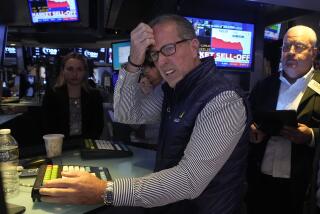Cyclically, We’re Back to the Past
- Share via
In the 1960s, in the midst of the Kennedy-Johnson economic expansion that lasted 35 quarters, economists hosted conferences with titles like “Is the Business Cycle Dead?” It was the apparent success of the Kennedy tax cut that allowed the hubris to think that well-designed fiscal policy could eliminate the business cycle. The 1970s dished out a rude comeuppance to this magical thinking.
Today, with 38 quarters of expansion under our belts, it is the magic of the New Economy that has been driving the optimism. On Tuesday, Federal Reserve Chairman Alan Greenspan said, “Technological innovation, and in particular the spread of information technology, has revolutionized the conduct of business over the past decade and resulted in rising rates of productivity growth.” In June, he said, “What differentiates this period from other periods in our history is the extraordinary role played by information and communication technologies. The effect of these technologies could rival and arguably even surpass the impact the telegraph had prior to and just after the Civil War.”
And Stephen Slifer, chief U.S. economist at Lehman Bros., risked the scorn of skeptics to say that he had begun to believe that recessions were no longer inevitable.
Not so fast. The personal productivity tools and communication devices of the New Economy do seem to have magical powers, but these powers do not end the business cycle. Quite the contrary; the New Economy has experienced a classic boom-and-bust cycle that is extraordinary only in its amplitude and brevity. The vivid image of the New Economy that is etched on most of our minds is the graph of the Nasdaq, which rose from 2,000 in January 1999 to 5,000 in April 2000 and is now back to 2,500.
There is a reason for this wild ride. In the Old Economy, the assets were structures and equipment, which take time to build and have substantial salvage value. The time to build slows the ride up, and the salvage value softens the landing. In the New Economy, the assets have been Internet ideas. These ideas seem to have emerged effortlessly and instantaneously from the minds of “Interpreneurs,” which has made for a wild ride up. But these ideas have very little salvage value; only a mascot is left from Pets.com. This has made for a wild ride down and probably a hard landing.
Last year’s New Economy question was “Is the productivity real?” Today’s humbled question is “How big will be the spillover?” Will the collapse of the stock markets and the bankruptcy cycle in the dot-coms create a tidal wave or only an imperceptible ripple?
My view is that the wave is big enough to end the Bush-Clinton expansion in 2001. Indeed, it is the New Economy boom that kept the Bush-Clinton expansion from ending in 1996. Those five extra years of expansion have allowed more overbuilding and a more precarious situation, especially in autos and other durables.
The downturn doesn’t have to be very serious. The greater stability of the economy since 1982 is the primary reason to believe that the downturn will be short and shallow. Dealing with our external deficit, however, could make the downturn longer and deeper. Today, net foreign investment exceeds $400 billion, which is more than 4% of GDP. If global investors lose interest in acquiring U.S. assets, this external deficit has to close, meaning we either have to export more or import less.
If global investors allow us the time, we can close the deficit by slowly expanding exports more rapidly than imports, as we did in the 1980s, without serious adjustment problems. If global investors suddenly lose interest, then the adjustment has to be more rapid, which means that it is mostly imports that have to do the job. This would require an unhappy combination of an income effect and price effect: lower GDP and more inflation from a weakening dollar. Think Mexico in 1995.
This is very bad news for Greenspan. The stability of the U.S. economy since 1982 is at least partly attributable to more forward-looking Federal Reserve policy. Prior to 1982, the Fed had acted like the homeowner who constantly adjusts the thermostat based on the current temperature of the house, and the temperature is never right. Especially under Greenspan, the Fed has adjusted the thermostat in anticipation of future warming or cooling needs, and the temperature has been much more stable and comfortable.
Now Greenspan, standing at the thermostat, sees a future that needs both more heating and more cooling. On Tuesday, he issued an elliptical promise to “remain alert to the possibility that weakening asset values could signal or precipitate excessive softening.” Investors optimistically took that Greenspeak to mean that they were enlisted into the front lines to fight the coming recession and that they would go into that battle with lower interest rates.
Though Greenspan may want to lower interest rates to fight off the looming recession, he may also want to raise interest rates to fight off the looming devaluation of the dollar and the inflation it may bring. Then again, he may want to slam the thermostat with a hammer because it doesn’t seem to be working like it used to; it is mostly gyrations in equities markets, not bond markets, that are driving this cycle. Thus 2001 promises to give old meaning to the New Economy acronyms B2B and B2C: Back 2 Bankruptcies and Back 2 Cycles.
More to Read
Inside the business of entertainment
The Wide Shot brings you news, analysis and insights on everything from streaming wars to production — and what it all means for the future.
You may occasionally receive promotional content from the Los Angeles Times.










